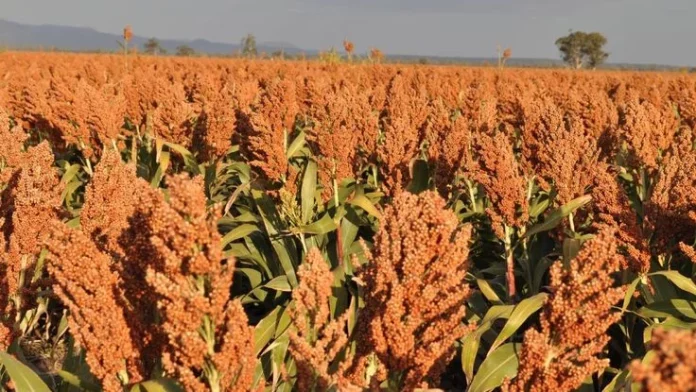Sorghum farming is one of the most practiced agribusinesses in Kenya’s semi-arid areas due to the crop’s ability to withstand drought.
The crop is mostly grown in eastern, coastal, and western regions including Meru, Tharaka Nithi, Embu, Kitui, Machakos, Makueni, Taita Taveta, Tana River, Migori, Homa Bay, Kisumu, Siaya, Busia, West Pokot, Elgeyo Marakwet and Baringo.
It grows in a wide range of soils from light alluvial sandy soils to heavy black cotton soils and is tolerant to insect pests like stalk Borers, Fall Army Worms, and a wide range of fungal diseases.
Sorghum has traditionally been regarded as a High-Value crop because it contains minerals such as Vitamin B, potassium, phosphorus, zinc, and iron. The crop is also a rich source of fiber and antioxidants.
Despite its profit potential, sorghum production remains low in Kenya at 135,000 metric tonnes as of 2022, compared to the production from other countries such as Nigeria and Ethiopia.
Nigeria is the largest sorghum producer in Africa, producing 6,725,000 metric tonnes. This is followed by Ethiopia, which had 4,450,000 metric tonnes.
The low uptake is attributed to various challenges including diseases, poor handling, post-harvest losses and unreliable market among others.
The East African Breweries Limited (EABL) is one of the top markets for sorghum in Kenya, which is used in beer making.
The company has contracted over 47,000 sorghum in Kisumu, Migori, Siaya, Homa Bay, Busia, Tharaka Nithi, Meru, Narok, and Nakuru, through their contract farming program.
Yacon farming: How Kenyan farmers are cashing from this apple tuber
The alcohol manufacturer listed on the Nairobi Security Exchange (NSE) says for a farmer to win a contract to supply sorghum, they must meet some requirements.
The company advises farmers to go for high-value white and brown sorghum varieties. The recommended white sorghum varieties are: Gadam (KARI/Kenya Seed/Dryland Seed), KARI Mtama (KARI), Sila (SeedCo) and Advanta Hybrid 23012 (Advanta Seed).
On the other hand, the recommended brown sorghum are Seredo, IESV 24029 SH, Horus seed-Hytech Kenya, and Advanta Hybrid SWGS3003.
Land Preparation
Sorghum requires a fine seedbed. Ploughing can be done either by hand hoeing, tractor or oxen. Ensure that the field has a fine tilth, it is advisable to harrow to the desired tilth as the sorghum seed is quite small.
The planting field should be prepared very early, immediately after harvesting the previous crop.
Planting
Dry planting is recommended to give the emerging plants a chance to utilize early rainfall and the nitrogen flush.
A seed rate of 4 kg/ acre should be observed. Additionally, when sorghum is planted as the sole crop, a spacing of 60cm X 20 cm should be observed.
Drill in furrows or plant in shallow planting holes. Plant at a depth of 5.0cm when dry planting and between 2.5-4.0 cm in moist soils.
Thinning – Thin when soils are moist preferably during the first weeding. Leave 3-4 seedlings per planting hole if the above spacing is maintained.
Government approves release of wasps to deal with papaya mealybug
Fertilizer Application
It is recommended that you do a soil analysis to determine the pH and nutrient status of your soils before buying fertilizer.
However, as a general guide apply between 1-2 bags of NPK or DAP during planting. When necessary top dress with one bag (50kg) of CAN per acre.
“1st weeding should be done within 2 to 3 weeks after emergence. The 2nd weeding should be done 2-3 weeks after the 1st weeding,” EABL states.
Crop Protection
Early-stage insect pests include sorghum shoot-fly and cutworms. It is recommended that growers use pyrethroid-based insecticides to control these early pests.
Later-stage insect pests are mainly the Fall Army Worm, African Army Worm, Stalk Borers. Use multi-action insecticides e.g. Coragen.
The major diseases include stem and leaf rust, smut, charcoal rot, and anthracnose which can be contained using seed dressed with a combination of fungicide and insecticide to control most of the diseases
Harvesting
Harvest the crop when the grain is hard and does not produce ‘milk’ when crushed between the fingers. The grain should be hard to pierce with a fingernail on harvesting.
The heads are harvested, threshed, and stored in cool dry conditions. Ensure threshing is done on a tarpaulin to avoid contamination with soil and sand. Maintain proper grain handling hygiene to ensure that your grain does not develop aflatoxin contamination.
Delivering to EABL
After harvesting, thresh and winnow your sorghum to make sure it has no rubbish. Ensure it is not mixed with other sorghum varieties and/or other crop grains.
Deliver your clean sorghum to the aggregation/collection centre where it will be weighed and ensure quality standards have been adhered to.
Direct Contracts: Pre-Shipment samples will be collected by your field officer who will advise on point of delivery.
Indirect Contracts: Contact your aggregator/ sub-agent who will advise
“EAML offers very competitive price for clean and graded sorghum delivered at designated EAML reception points, or to a KBL-appointed aggregator collection facility.”
The company maintains that all farmers, farmer groups, agents, and transporters willing to participate in the EABL sorghum value chain must adhere to the Company’s Code of Business Conduct available on www.eabl.com or www.diageo.com








